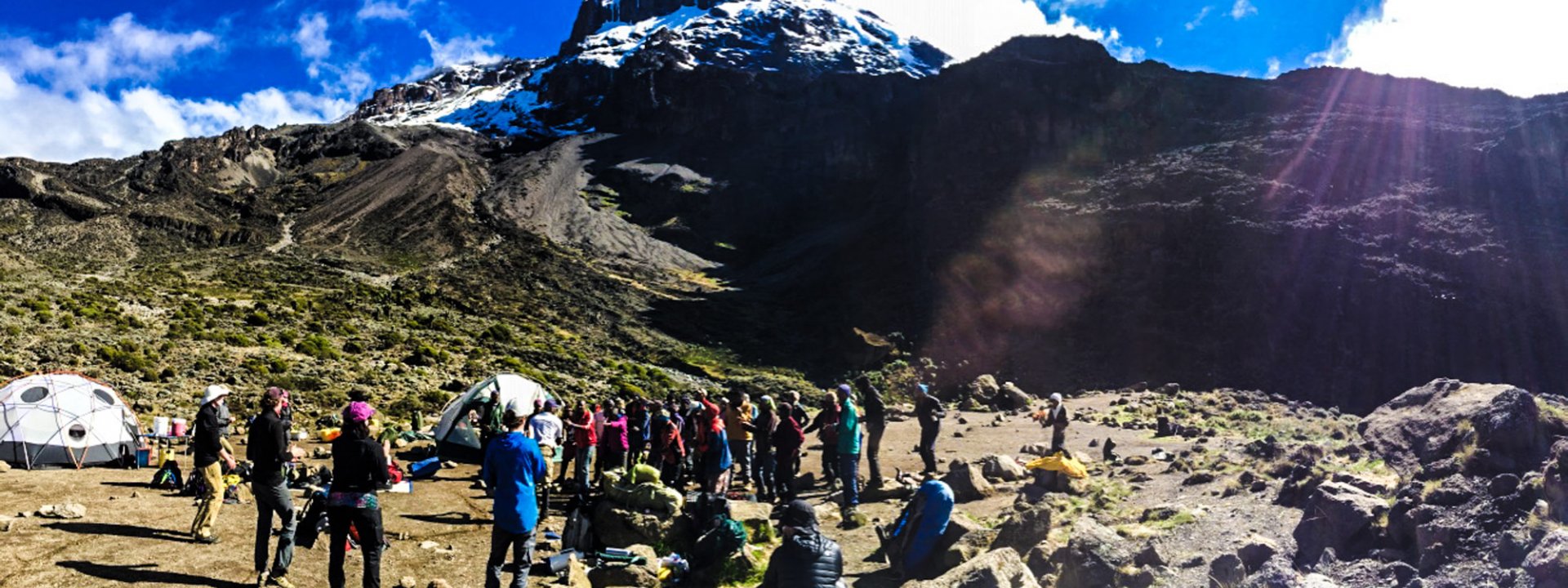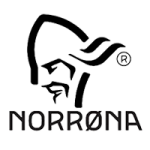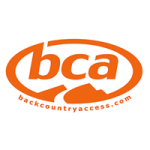|
|
Quantity |
Note |
|
Headlamp |
1 |
Bring two sets of fresh batteries |
|
Trekking Poles |
1 |
3 section poles that fit inside your travel duffle |
|
Hiking Boots |
1 |
1 pair of sturdy boots in which you can wear a light synthetic sock under a heavy sock comfortably, either wool or synthetic. Boots should be very waterproof and very warm. |
|
Gaiters |
1 |
Be sure gaiters fit with hiking boots. |
|
Wool or Synthetic Socks |
3 |
3 pair heavyweight socks to be worn over the liner socks. When layering socks, check fit over feet and inside boots. |
|
Liner Socks |
3 |
3 pair of smooth thin wool, nylon or Capilene to be worn next to the skin. This reduces the incidence of blisters and hot-spots and makes the outer sock last longer before needing to be changed. They should fit well with your heavyweight socks. |
|
Running or Tennis Shoes |
1 |
1 pair to wear around camp and also for safari. |
|
Synthetic Short Underwear |
2-3 |
2-3 Pairs of NON-Cotton short style underwear. (boxers, briefs, etc.) Amount based on personal preference. |
|
Light Long Underwear |
2 |
2 pair tops & bottoms, Capilene, other synthetic or wool. No Cotton. Lightweight is preferable as it is more versatile. Zip-T-neck tops allow more ventilation options. |
|
Heavyweight Long Underwear |
1-2 |
1or 2 pairs top and 1 pair bottom. Synthetic or wool. No Cotton. Heavier and warmer than the lightweight layer above. Used as a layering/ warmer piece over lightweight layers for colder conditions, such as summit night. Also for sleeping in, and down time in camp when not climbing. |
|
Trekking Pants |
2 |
Lightweight nylon trekking pants worn during start of climb and safari. |
|
Soft Shell Pants |
1 |
These non-insulated pants can be worn in place of trekking pants while on the climb, especially higher up and for summit night. They provide a higher level of warmth and also repel light rain. |
|
Soft Shell Jacket |
1 |
Mid-heavyweight. A full-zip version is easier to put on and has better ventilation than a pullover. |
|
Hard Shell Jacket w/ Hood |
1 |
We recommend a waterproof breathable shell material with full front zipper, underarm zips, and no insulation. This outer layer protects against wind and rain. |
|
Hard Shell Pants |
1 |
Waterproof, breathable pants that are easy to put on and take off. Short ankle zippers are fine as long as it's not difficult to pull your pant legs over your boots. |
|
Insulated Down Jacket w/ Hood |
1 |
Medium to heavy weight with hood. Cut large for layering over long johns, soft shells and/ or hard shells. |
|
Insulated Micro-Puff Jacket |
1 |
Thin cut, for layering underneath shells. Used more frequently than the heavier summit down jacket, and easier to fit in the pack. Especially useful for those people that are cold easily. May be synthetic or down material. |
|
Buff |
1 |
Most versatile face/neck protection available. |
|
Wool or Synthetic Ski Hat |
1 |
Make sure ears are covered. |
|
Balaclava |
1 |
Lightweight. Look for a simple lightweight model. |
|
Baseball Cap or other Sun Hat |
1 |
One with a good visor to shade the nose and eyes. Synthetic (quick dry). |
|
Bandanas |
1-2 |
To shade the neck. Many other uses such as a washcloth. |
|
Glacier Glasses / Sport Glasses |
1 |
Regular sunglasses are usually not sufficient. 100% UV, IR, high quality optical lenses designed for mountain use, must have side covers and leashes. No more than 10% light transmission. If you wear contact lenses we recommend packing a spare pair of glasses - it is a good idea to have these with "photo-gray" or equivalent light-sensitive material so they can double as emergency sunglasses. If you wear glasses we recommend prescription glacier glasses (gray or amber). |
|
Lightweight Synthetic Liner Glove |
1 |
To wear alone on very sunny days for hand protection or as a layering piece with your Shell mitts. |
|
Waterproof Gloves |
1 |
Lightweight, waterproof gloves for hiking in the rain and cool temps. Suggested: Outdoor Research Versaliner glove or similar: http://www.outdoorresearch.com/en/mens/gloves/mens-versaliner.html |
|
Insulated Shell Mitts |
1 |
Mitts are much warmer than gloves, as the fingers are together in the same compartment. Many people underestimate how cold the summit night can be. |
|
Hand Warmers |
2 |
Primarily for summit night. These are another tool to help keep fingers warm in cold conditions. |
|
Trekking Backpack |
1 |
A day pack big enough to carry water bottles, camera, lunch and extra clothing. 3,000 cu.in. max. |
|
Sleeping Bag |
1 |
(Expedition quality rated to at least 10°F). Your bag needs to be long enough that your feet are not pressing out the foot box which will make you colder. It should be roomy enough for comfortable sleeping but snug enough for efficient heat retention. |
|
Self-Inflating Sleeping Pad |
1 |
One full length pad. Make sure to include a valve stem and patch repair kit. |
|
Sunscreen |
2 |
SPF 40 or better. Note: Sunscreen older than 6 months loses half of its SPF rating, make sure that you have new sunscreen. |
|
Lipscreen |
2 |
SPF 30. Make sure your lipscreen is new. |
|
Waterproof Stuff Sacks |
3 - 4 |
A variety of sizes is nice, keep gear inside hiking pack dry. |
|
Pack Cover |
1 |
Waterproof backpack cover for travel in rainy / wet conditions. |
|
Pee Bottle |
1 |
1 Liter. Large mouth, clearly marked water bottle. Collapsible 1 liter canteen takes up less volume than a bottle when empty. |
|
Water Bottle |
2-3 |
Wide mouth bottles with minimum 1 Liter capacity per bottle. Hydration systems like Camelbaks are fine to use during the climb, but you MUST have at least 2 one-liter bottles for summit day because of freezing. |
|
Water Bottle Holder |
2 |
Recommended for summit day. Fully insulated with zip opening. Neoprene "cozy" style does not provided enough insulation and is not recommended. |
|
Insect Repellent |
Small Bottle |
|
|
Toiletry Bag |
Small travel size containers. |
Include toilet paper, soap, wet wipes, toothbrush, towel, hand sanitizer, foot powder, ear plugs etc. |
|
Camera Gear |
1 |
We recommend small instant point and shoot cameras. Please do not bring large SLR cameras with extra lenses. Simple and light. |
|
Travel Duffle |
1 |
90 Liter Duffle Bag. Recommended Patagonia Black Hole 90L Duffle |
|
Travel Locks |
2 |
TSA style travel locks. For in country and expedition. |
|
Small Duffle Bag |
1 |
A small duffle can be nice for storing things at the hotel during the expedition and extra clothing while traveling. |
|
Trash Compactor Bags |
3-4 |
To line stuff sacks, daypack, and general organization of gear inside the porter/duffle bag. Trash Compactor bags are made from a heavier plastic. |
|
Travel Clothes |
|
You will need clothing for three days of safari. Loose fitting cotton trousers or shorts and short sleeve shirts work well during the day. Bring a light jacket for town & safari. Evening time can be cooler. Safari lodges are quite nice, so long pants and a nice shirt are recommended for dining. Bathing suit for hotel pools. |
|
Trail Snack Food Items |
|
Trail snacks are provided each day, in addition to a sit down lunch, and breakfast/dinner. The foods are plentiful and varied. Climbers only need to bring the Special supplements below, UNLESS they have dietary restrictions , or concerns. Special energy supplements: 5-6 Servings GU/Shotblocks etc for summit Day. These are easily metabolized simple sugars/carbs -Not power protein bars. 3-5 (Total) Additional bars/snack favorites to supplement remaining climb days. |
|
Cash |
We will discuss this custom during our Q/A phone call. |
Necessary: $100 new, crisp bill for Tanzania Travel Visa. Paid upon arrival at customs. |
|
Small Personal First Aid Kit |
|
(Simple and Light) Aspirin (Extra Strength Excedrin is best), Antibiotic ointment, Moleskin, molefoam, waterproof first-aid tape, athletic tape, Band-Aids, personal prescriptions, etc. The guides will have extensive first-aid kits, so leave anything extra behind. Please let your guide know about any medical issues before the climb. |
|
Drugs / Medications / Prescriptions |
|
Climbers should bring Pepto Bismol, and Immodium. Ciprofloxin (Cipro) 500mg tablets for traveler’s diarrhea and for urinary tract infections. Azithromycin (Z-pak) 250mg tablets for non-gastrointestinal infections. Acetazolamide (Diamox) 125 or 250 mg tablets for altitude sickness. Ibuprofen (Advil, Motrin) 200mg tablets for sprains, aches, etc. Extra Strength Excedrin for altitude headaches. Acetaminophen (Tylenol) 325mg tablets for stomach sensitivity. |






